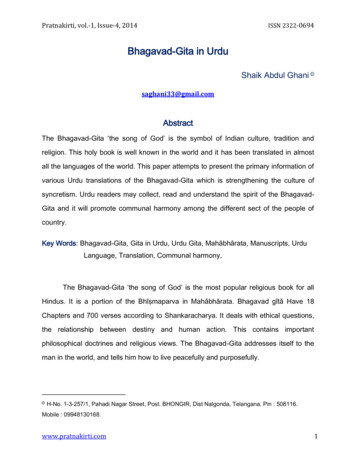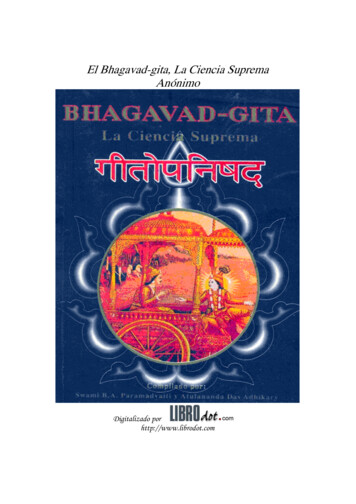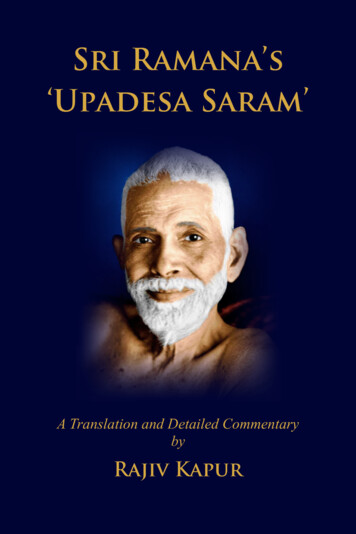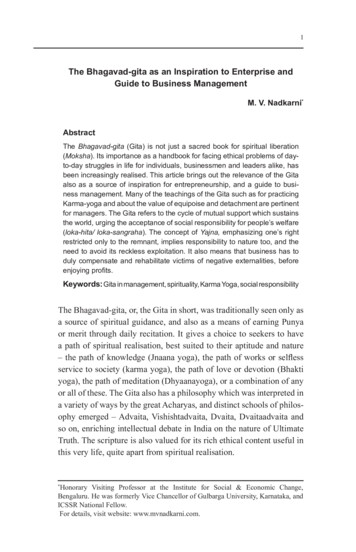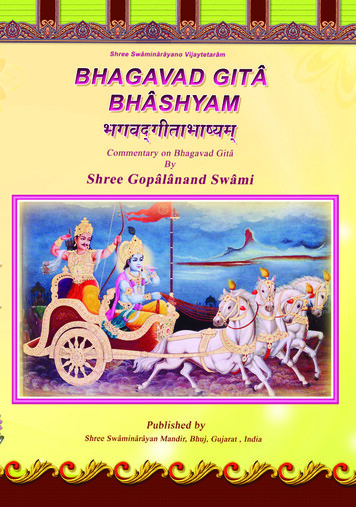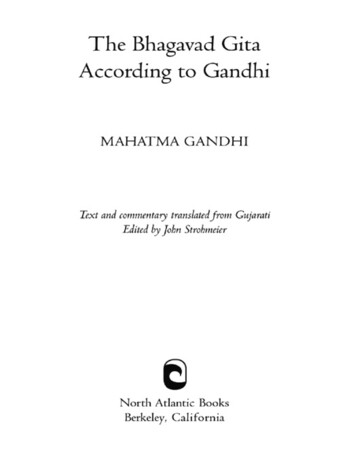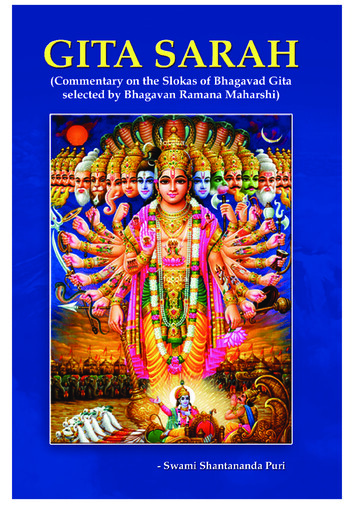
Transcription
b
GITA SARAHGITA(Commentaryon the slokas of Bhagavad Gitaselected by Bhagavan Ramana Maharshi)Swami Shantananda PuriPARVATHAMMA C.PPARVATHAMMAC.P.P. SUBBARAJU SETTYCHARITABLE TRUSTCHARITABLE13/8, Pampa Mahakavi Road, Bangalore - 560 004.Telefax : 2670 8186 E-mail : omkaroffset@gmail.comGita Sarahiii
Gita Sarah - A commentary,Sarahby Sri Swami Shantananda Puri Maharaj,on the slokas of Bhagavad Gita selected byBhagavan Ramana MaharshiAll the books ofH.H.Sri Swami Shantananda Puri Maharajare available uriEdition : 2010Copies : 1000Cover design & Printing :Omkar Offset PrintersNo. 3/4, 1st Main Road, New Tharagupet, Bangalore - 560 002Telefax : 2670 8186 E-mail : omkaroffset@gmail.comWebsite : www.omkaroffset.comivGita Sarah
DEDICA TIONDEDICADedicatedat the holy feet ofBhagavan Sri Ramana,the greatest luminary in thefirmament of spiritualityin the recent pastwith respectful prostrations.- Swami ShantanandaShantanananandaGita Sarahv
Gita Sarahvii
INTRODUCTIONINTRODUCTIONBhagavan Ramana Maharshi ofTiruvannamalai (Arunachala)fame, out of his compassion, selected 42verses out of the 700 verses of SrimadBhagavad Gita, as representing thequintessence of the entire Gita. It wasahcalled Gita SarSarahah. The anecdote as to howhe came to select them is interesting. Adevotee once requested Bhagawan Ramanato give one sloka from the entireBhagawad Gita which would represent theessence of the entire Gita. He alsoexplained how it would be easy to committo memory one verse instead of the entireGita. Bhagavan Ramana selected and gavehim one verse which comes as Sloka 4 inGita Sarah. Later on he seleced all the 42verses. He had selected them from all thechapters in the order of their importanceand not sequentially. In this selection hismain emphasis is on the Supreme Self andGita Sarahix
keeping one’s attention fixed on the Self.Even regarding the words Bhakti, surrenderetc., Bhagavan has translated them as Jnanaor ultimate knowledge. In this book, theauthor, while giving the meaning of eachsloka, has closely followed thecommentary of Adi Sankara. For instance,ambhah’ translatorsfor the word ‘Samar‘Samarambhah’have given the meaning as beginning ofenterprises but as per Sankara it is ‘SarvaKaramani’ – All activities and notYasya sarve samarambhah.beginnings. (Yasyasarvsamarambhah.For almost all the slokas, BhagavanRamana’s views on the topic dealt with inthe slokas have been quoted citingreference to the ‘Talks with Bhagavan”.Each one of the selections is a gem.Hence, besides the meaning, a fairlyelaborate commentary has also been givenfor each sloka.Srimad Bhagavad Gita is well known evento the school children in India. For theVedantins (Scholars in the philosophy ofnondualism) Sruti (Vedas) and Smriti arexGita Sarah
the main authorities and the Bhagavad Gitais a deemed ‘Smriti’. Bhagavad Gita has alot of unique features which are notavailable in any other sacred text.For instance, the word ‘Yagna’ (sacrifice)has been used since the Vedic days forthe elaborate fire sacrifices whereoblations were given to gods so that theperformer could reap various benefitsincluding going to heaven. In Gita, themeaning has been generously extended toinclude all the activities where one spenttime, energy, money etc., either for thebenefit of others or for pleasing the Lord;for example – Jnana Yagna where onespends his time in propagating knowledgeto others, tapo yagna where one doespenance to the Lord and Swadhyayawhere one studies scriptures forpropagation to students later etc.The other special feature is thecategorization of penance (tapasya), faith(Sradha) etc. into three kinds according tothe three Gunas. When Ravana orGita Sarahxi
Hiranyakasipu did tapasya, it was for thedestruction of the world and oppression ofthe virtuous etc. and hence it was based onTamoguna. That is why they all came to abad end. Thus Gita is a unique text whichwill be interesting even for the people ofmodern age including those of the otherWestern countries too. By placing before usthe essence of it in 42 verses BhagavanRamana has done a wonderful service tothe world.I hereby acknowledge that I haveprofusely quoted from the book“Talks with Sri Ramana Maharshi”and I thank the Publishers, SriRamanasramam, gatefully, whose otherpublication “Gita Sarah” is the maintopic of the text.May we all be recipients of the Grace ofthe Supreme Lord and Bhagavan Ramana.- Swami Shantanandar r rxiiGita Sarah
Gita Sarahxiii
SRI GITASARAHGITASARAH(BY BHAGAVAN SRI RAMANA)BHAGAGAVRAMANA)Mangala SlokaP rtha S rathi RoopenaSr vayitv Subh m Giram lP rthasy rtiharo DevahKrup moortih Sa patu nah llAt the start of any religious or spiritualtext, the author normally composesa verse known as ‘mangalacharanam’invoking the grace of a God preferablyrelevant to the text. The purpose is to seekthe blessings of the Lord for a smoothcompletion of the text without encounteringany obstacles. Such a sloka is also expectedto indicate four factors viz. (1) Adhikari- WhoGita Sarah1
is qualified or fit to study this text (2) Vishayah– The topic to be dealt with (3) Sambandha- The relationship of this text with the subjecttopic (4) Prayojana [What is] The purposeexpected to be achieved by reading this text.In this starting verse, Bhagavan hasindicated that Lord Krishna was compassionembodied (Krupamoorthih) and wasintent on removing the distress of Arjuna(Parthasyarthiharo). This means that allpeople irrespective caste, creed, age orqualifications who are in deep distress areentitled (Adhikari) for studying this text. Thetopic is “Instructions which lead to theauspicious end of attaining liberation(Subham giram)”.The Sambandha is that this text is meant toexpound the topic mentioned above. Thepurpose or prayojana is “relieving the2Gita Sarah
distressed people of their miseries andsufferings (arti) in this world forever”.The simple meaning is :May the Supreme Lord who, as anembodiment of compassion appeared inthe form of a charioteer to Arjuna andremoved the distress of Arjuna byinstructing him in words leadingultimately to Self-realisation andliberation, protect us allr r rGita Sarah3
(1) Sanjaya Uvacha Tam tath krupay vishtamasrupoorn kulekshanam lVishidantamidam v kyamuv cha Madhusudanah ll(Chapter II -1)Sanjaya narrated –Lord Krishna spoke these following wordsto Arjuna who was in distress and thusovercome with self-pity, with eyes agitatedby and brimming with tears.Bhagavan Ramana has selected 42verses representing the essence ofthe seven hundred verses of Bhagavad Gita.4Gita Sarah
A doubt arises as to how this verse can beconsidered as important enough to meritselection and that too as the first one. Thefirst chapter of Gita is known as Vishadayoga i.e a path to unite with the Lordthrough suffering and distress. Whenevera person reaches the deepest level ofdespair and despondency and surrendershimself unconditionally to the SupremePower, the indwelling divinity revealsitself and guides him to the ultimate goalwith words of highest wisdom. WhenDevahuti surrendered herself to Kapila(an incarnation of the Lord), the lattergave to the world a ‘Sankhya yoga’ in theform of advice to his mother. When KingParikshit surrendered himself to SukaDeva, “Srimad Bhagavatam” flowed fromthe lips of the latter. There is no limit tothe compassion of the Lord and hence itGita Sarah5
is that there can be no drop-outs in thespiritual field. This verse indicates thateven at a time of dire despair and utterhelplessness, surrender to the Lord is theonly way to redemption. When once weweep before the Lord in utter humility,surrender and confess our sorrows, itopens up a path for God - realization(Yoga). “Distress often leads men to faithin God”. (Talk No. 43)r r r6Gita Sarah
(2) Sri Bhagavan uvacha Idam sariram KounteyaKshetra mityabhideeyate lEtadyo vetti tam pr huhKshetrajna iti tadvidah ll(Chapter XIII-1)Krishna said:Oh Arjuna, this body is termed as Kshetrai.e., a field. The one who knows this fieldis called the Kshetrajna i.e., the knowerof the field, by the experts i.e., the sages.The entire Vedanta philosophypurports to blast away thecommon misconception of identifying thebody as the Self, as the first step. EveryGita Sarah7
human being consists of two differentunits with opposing characteristicsnamely (1) the body and (2) the spirit –Consciousness absolute which can beroughly likened to a living, loving energy.While the body is unreal, Consciousnessis the only undivided reality whichpervades all the bodies. The word Sariram(body) is derived from “Srng” meaningthat which is always degenerating ordepreciating. This body has been likenedto a field. In a field if we sow good seedsof fruit – bearing trees, we will haveexcellent produce of sweet fruits. On thecontrary, if we sow thorns, we will get aproduce of thorny plants. Similarly if weuse the body to do good deeds, we willearn merits which will rebound to ourgood. On the contrary, if used for evildeeds, it will bring suffering and miseries.Just as a gardener is fully knowledgeableabout his garden as to where and whichtrees or plants exist, the individual soulknows the body thoroughly and is called8Gita Sarah
a knower of the field (kshetrajna). In ourhouses, each of the bulbs which giveslight consists of two units, namely thebulb and the electricity inside the bulb.Ultimately there is no separate electricalenergy coming into the different bulbs. Itis the one electricity which comes out ofthe generator which goes into each bulb.Thus electricity in each bulb, irrespectiveof the wattage- zero watt, one hundredwatt etc. is not a separate individual unitbut the same as the totality of electricalenergy pervading all the bulbs and is incontinuous contact with the generator. Inthe same way, the individual soul(Jivatma) in each body (bulb) is in realityan integral indivisible part of the SupremeBeing (Brahman) which can be likened tothe electricity from the generator. This iswhat is going to be explained in the nextverse that the individual soul (kshetrajna)is in reality the same as the universalSupreme Being (Supreme Brahman).r r rGita Sarah9
(3) Kshetrajnam c pi m mviddhi sarva kshetreshu Bh rata lKshetra kshetrajnayorJnanam yattat Jnanam matam mama ll(XIII-2)Oh Arjuna, know that the individualknowers (kshetrajna) in all the bodies areall identical with me (the Supreme Being).It is this discriminative knowledge of boththe bodies and the kshetrajnas which,according to me, is the ultimate trueknowledge of the Absolute.This body and Atman have opposingcharacteristics. The body is subjectto mortality and the six changes (Shat Bhava)namely- “It is born, it exists (is), it is subject10Gita Sarah
to transformations, it grows, it deterioratesand dies”. Atman is immortal, immutable,and is not subject to any changes. It is likethe bulb and the electricity. If we throw astone on a bulb, the latter is broken topieces but the electricity does not geteven a scratch. When I say ‘I’ referring tothe Self, it does not refer to the body andthe senses. The one who sees throughthe eyes, hears through the ears, walkswith his legs and does all these functionsis not the eye, ear etc. The eye, ear etc.which are part of the body, though wideopen after the death of a person do notsee or hear. It is the power of Atmanwithin, which functions through the hoesof the eyes, ears etc. There is only oneenergy which goes into all the bulbs(bodies) and the quantum in each bulbis called the Atman. This knowledge willenable us to remove our ignorance infalsely identifying ourselves with the bodyGita Sarah11
and thus attain the true knowledge i.e.Self - realisation. “Since you areidentifying yourself with the physicalbody, you speak of the world as beingphysical and the other world as spiritual.Whereas that which is, is only spiritual.If you find that you are not this body butthe spirit, you will be free from gross orsubtle bodies, and then there will beno limitations.” (Talk No. 328)r r r12Gita Sarah
4) Aham tm Gud kesa sarvabhoot saya sthitah lAham discha madhyam cabhootan manta eva ca ll(X-20)Oh Arjuna, I am the Self indwelling in thehearts of all beings. I am thus thebeginning, the middle, as also the end ofall beings.According to Bhagavan Ramana, thisverse is the most important in theentire Bhagavad Gita.In a dream, I may see several people andall of them are not only my creations(creations of my mind) but I constitute thematerial cause out of which all these peopleGita Sarah13
have been created (just as the mud is thematerial cause for a mud- pot). In other words,all the dream figures are my mentalimaginations. (mere thoughts.)It is I who appear as having been bornas the various people in the dream, I only runtheir lives in the dream as the Self in all thosebodies and I also appear as having died oneday. In the same way, it is the one AbsoluteConsciousness which appears as severalbeings in the world of the waking state (thebeginning) , runs the lives as individuals (themiddle) and appears as subject to death (theend) one day. In reality there is nothing butthat one Consciousness which is the absolutetruth. There is no world apart from that oneConsciousness (Self).“The Pure being is the Reality. ----- ThePure Being cannot be otherwise than14Gita Sarah
Consciousness. Otherwise you cannot saythat you exist. Therefore Consciousness isthe reality. When that consciousness isassociated with upadhis you speak of Selfconsciousness, unconsciousness, ----human consciousness, dog consciousness,tree consciousness and so on. Theunfaltering common factor in all ofthem is Consciousness.” (Talk no 591).‘Consciousness’ means to be aware that‘I exist’, This awareness of our existenceis consciousness.r r rGita Sarah15
(5) J taysa hi dhruvo mrtyrdhruvam janma mrutasya ca lTasm daparih ry rthe na tvamsocitu marhasi ll(Gita II -27)For the one who is born, death is certainand vice versa too, in that, for the one whodies, rebirth is inevitable. Hence (OhArjuna!) it does not behove you to grieveover a matter which is inevitable.It is the law of nature that any objectlike the body of a human being whichis born will be subject to death also. The oneConsciousness which pervades all bodies,being eternal, is not subject to either birth ordeath. There is no use of grieving over the16Gita Sarah
death of a body which, by its very nature, istransient. One should always remember thatone is not the body but the eternal Self whois the one who resides in all the bodies. Thereis no need to grieve over the bereavement ofa body. “If one dies, it results in grief for theother who lives. The way to get rid of grief isnot to live. Kill the one who grieves.Who willremain then to suffer? The ego must die. Thatis the only way.” (Talk No 252).“If a man considers he is born, he cannotavoid the fear of death. Let him find out if hehas been born or if the Self has any birth. Hewill discover that the Self always exists, thatthe body which is born resolves itself intothought and that the emergence of thoughtis the root of all mischief.” (Talk No 80)r r rGita Sarah17
(6) Na j yate mriyate v kad chitn yam bhootv bhavit v na bhooyah lajo nityah s svatoyam pur nona hanyate hanyam ne sarire ll(II -20)The Atman is not born nor does it everdie. It is not also that after being born, itceases to be anymore (i.e. dies). He isunborn, eternal, everlasting and ancient.Even if the body is slain, Atman remainsfor ever unharmed.Unlike the body, Atman is neversubject to any changes like growth,decay, transformation, birth, death etc. Itremains forever.18Gita Sarah
By saying that the Self is ancient, it onlymeans that it never grows and though it hasbeen there at all times it always looks newand fresh (as per Sankara). Even if we throwa stone at a bulb, it is the bulb which isshattered to pieces and no harm or no scratchever befalls the electricity. In the olden daysthe example of the pot and the space inside(ghatakasa) used to be given. Even thoughthe pot may break, the space inside remainsunaffected. It is the same case with the bodyand the Atman (Self). Even if somebody is tomassacre the body, the Self cannot be slain.It is futile to grieve over a broken containerso long as the contents remain unharmed.“Accordingly, there is neither birth nordeath.Waking is birth and sleep is death. ----What if anyone is dead? They are free frombondage. Mourning is the chain forged by themind to bind itself to the dead.”Gita Sarah19
“There will be no more pain if thephysical outlook is given up and if the personexists as the Self. Mourning is not an index oftrue love. It betrays love of the object, of itsshape only. That is not love. True love is shownby the certainty that the object of love is inthe Self and that it can never become non –existent.” (Talk No. 203)r r r20Gita Sarah
(7) Acchedyoyamad hyoyamakledyo (a) soshya eve ca, lNityah saravagatahsth nurachaloyam san tanah ll(II-24)The Self is incapable of being piercedthrough or burnt by fire; nor can it bewetted (dissolved in water). It cannot alsobe dried up by air. It is eternal, allpervading, stable, immovable andeverlasting.Why is it that the body is subject todeath? The body is constituted ofthe five basic elements viz; earth, water, fire,air and space. As the bone and flesh are madeup of ‘earth element’ also, it can be cut orGita Sarah21
pierced by a weapon like a sword. The soulhas no parts or constituents and it is likeenergy. So it cannot be cut or pierced through.Unlike the body it cannot be burnt by fire. Allthe five elements cannot cause destructionto the Soul. Being eternal, it is all pervading.Being all pervading, it is very stable. Beingstable, it is immoveable. It has not beencreated anew from any prior cause andhence it is ancient or everlasting. This pointhas already been described in different wordsin the earlier verses above but this repetitionis intentional in that this mistaken notion ofthe body being considered as the Self maybe eliminated and the reality and nature ofAtman alone can be realized by the worldlypeople.r r r22Gita Sarah
(8) Avin si tu tadviddhi yenasaravamidam tatam lVin sa mavyayasy sya nakaschit karturmarhati ll(II-17)Know that alone to be imperishable whichpervades the entire universe. This beingindestructible, nobody is capable ofcausing its destruction.The idea conveyed in the verse isexactly the same as alreadydiscussed in previous verses. This alsopurports to emphasize the immortality of thisAtman which is the Self of all. As the Self iseverywhere who else is there anywhere, whocan destroy it?Gita Sarah23
Question: - Swamiji, from theprevious verses it is clear that Atman(Self) never acts and is all perfection andpurity. If so where does the question ofpurification of mind come in?Answer:- So long as the body-mindcomplex looks real and so long as weare under a misapprehension that we arebound, we have to do sadhana to removethe false identification of the Selfwith the body. We remain ever realised(nitymukta) and due to a falseconception we are convinced that we arebound souls and identify ourselves withthe false body-mind complex with all itsprior conditioning and its consequentimpurities accumulated in the mind, likeattachment, hatred, envy, anger etc. Evenafter taking full meals, if we go to sleepand dream that we are hungry, we haveto search for a hotel in the dream and24Gita Sarah
take meals there. When once we are inan illusion that we are the body- mindcomplex, we have to do sadhana topurify the mind and then wake up fromthe dream. We have to get rid of what wehave imagined ourselves to be by furtherimagination of sadhana. In reality, themind being false there is no question ofpurification of mind. If only we canremain in the ever present awarenessthat we are the Atman who is inactiveand is only a witness, it is liberation.Purification of mind is the effort done inthe dream in order to wake up to reality.r r rGita Sarah25
(9) Naasato vidyate bh vonaabhavo vidyate satah lUbhayorapi drshtonta Stvanayos tatwa darsibhihi ll(II-16)The unreal (asat) has no existence andthe real (sat) never ceases to exist. Therelative reality of both (sat and asat) hasbeen perceived by the seers of theultimate truth.This verse reads like a riddle. It istold that Lord Ganesha who waswriting down when Vyasamaharshi wasdictating Mahabharata, had put acondition. The condition was that hewould continue writing only so long as26Gita Sarah
Vyasa was able to dictate continuouslywithout pausing even for a minute. Vyasahad also put a counter condition thatGanesa should not proceed ahead withwriting until and unless he thoroughlyunderstood the meaning of the verseunder dictation. So, Vyasa deliberatelyintroduced some riddle- like verses inBhagavad Gita (which was part ofMahabharata) so that by the time Ganesapaused to think of the meaning of such averse, Vyasa was able to gather histhoughts for further dictation.In the classical texts, the following isthe example given to define an ‘Asat” orunreal object:“There goes the son of a barrenwoman with his head adorned by flowersgrown in the sky and carrying a horn ofrabbit”. Here, there cannot be the son of abarren woman who is an asat but youGita Sarah27
may see one in your dream. Similarly theflower in the sky as also the horn of arabbit are unreal objects and cannot havean existence of their own except in adream or imagination. Here, Asat refersto the body and also to opposite pairs(Dvandvas) like heat and cold, pleasureand pain etc. These ‘Asat’ objects haveno existence of their own. They are allproducts of the mind imagined due topast conditioning. The body is thus asuperimposition like the dream objectsseen in a dream. If a pot is made up ofclay, pot is only a transformation of clay. Itis the clay which was its material causeand it only sustains the form of a pot. So apot is called ‘asat’. Pot is a name given toa transformed form of clay. The pot has notrue existence as such.By ‘Sat’ is meant the final truth i.e. theAtman (Self). As it is all pervasive and28Gita Sarah
ever present in all beings, there is notime or space where the Self ceases toexist. It is the seers of yore who, as resultof their Self-enquiry and Self-relaisation,were able to come to their firmconclusion about the distinction betweenSelf and non-Self which are known as Satand Asat respectively (as per SankaraBhashya on Gita). “Yes it is like a cinemashow. ----- You are the screen. The Self hascreated the ego, the ego has its accretionof thoughts which are displayed as theworld, the trees, plants, etc., of which youare asking. In reality, all these are nothingbut the Self, the same will be found to beall, everywhere and always. Nothing butthe Self exists.” (Talk No. 13). This versehas been quoted verbatim by BhagavanRamana in talk No 203 also.r r rGita Sarah29
(10) Yath sarvagatamsoukshmy t k sam nopalipyate lSarvatr vasthitito dehetathaatm nopalipyate ll(XIII-32)The all- pervading space (though it is incontact with varieties of worldly objects)never gets contaminated or tainted withthe qualities of the objects because of itssubtle nature. In the same way, the Selfwhich pervades the entire body nevergets affected.The space is everywhere and is inclose contact with all the objects ofthe world which are all contained in it. In spiteof this, the differing nature or qualities of the30Gita Sarah
objects-say, the fragrance of flowers, the badodour of the gutter, the smell of asafoeitidaetc., do not get superimposed on the space.The space continues to remain unaffectedand pure. In the same way, Atman which iseverywhere in all the bodies of variousbeings, does not absorb any of the qualitiesof the body or other objects around it. Thebody may have signs of old age, diseases withfoul smell, but none of the attributes touchthe Atman which has no attributes.In this connection, one is reminded of theconversation between Jadabharata, a realizedsage and a king called Rahugana, in SrimadBhagavatam.When the king taunts the formerfor his lack of attention and alertness whilecarrying the king in a palanquin, the sagereplied:“Leanness, stoutness, diseases, mentalworries, hunger, thirst, fear, quarrel, desire,decrepitude, sleep, anger etc. - all theseGita Sarah31
affect a person who considers the body as theSelf and thinks that he was born with thisbody. They do not apply to me who remainsas the Self and has no body - sense.”“Thesoulremainsalwaysuncontaminated. It is the substratum runningthrough all these three states. Wakefulnesspasses off, I am: the dream state passes off, Iam, the sleep state passes off, I am. Theyrepeat themselves, and yet I am. They are likepictures moving on the screen in a cinemashow. They do not affect the screen.” (Talk No244)r r r32Gita Sarah
(11) Na tad bh sayate sooryo nasas nko na p vakah lYad gatv na nivartantetad dh ma paramam mama ll(XV-6)Neither the sun nor the moon nor the firecan shine or illuminate that final state(which is self effulgent). That state is mySupreme abode wherefrom the peoplewho once reach it do not return to theearth again.Whenever we want to see anyobject we require the sunlight,moonlight or light of fire, electricity etc. Ifa torchlight enables us to see the objectsin darkness, there is no need for a secondGita Sarah33
torchlight to see the first one whichreveals itself also. Atman is self effulgent.When once the state of Self-realisation isattained there is no more death or rebirth.Althoughthesunandotherluminaries are said to be self –luminous,yet they do not shine forth of themselvesbut they shine by the light of the SupremeBeing.As regards the second line of theverse Bhagavan Ramana has explained itin a unique way. He confirms that thosewho reach the cosmic consciousness havenot escaped from the clutches ofignorance. “As long as you think thatthere is a ‘gati’ (movement) - as implied inthe word ‘gatva’ (having gone to) - there is‘punaravritti’ (returns) also. Again gatiimplies your ‘punaragamanam’ (birth).What is birth? It is birth of ego.34Gita Sarah
Once born you reach something.If you reach it you return also. Therefore,leave of this verbiage. Be as you are. Seewho you are and remain as Self, free frombirth, going, coming and returning.” (TalkNo 181). This is the ultimate significanceof this verse.The entire works of Vyasa are in‘Samadhi bhasha’ - the language of superconsciousness. It is told ‘Samadhi bhashaVyasasya’. In other words, besides themeaning derived from a dictionary, thereare other esoteric interpretations whichcan be obtained by meditating on eachverse. Here, for instance, the sun, moonand fire have not been cited in a casualmanner. As per the Vedas (PurushaSooktam) and astrology, the sun is thesource of the eye, moon the source of themind and fire, the source of speech (vak).Hence the fact that the sun, moon and firefail to shine in the final abode of theGita Sarah35
Supreme Self means that the final goalis such that our gross eyes cannotsee, the mind cannot conceive andwords or speech cannot describe. It isbeyond mind and speech. (“yato v chonivartante apr pya manas saha.”) i.e.,transcendental. It is self-revealing. TheSupreme abode only means our realnature i.e. to remain as the Self.Question: - Can this sloka purport toconfirm a common saying that the path toGod and the state of yearning for unionwith the Brahman are greater than theunion itself.Answer: - When once we reach thefinal goal of Self-realisation, there will nolonger be any pyrotechnics. We cannotcompare the stage of sadhana with thefinal goal. The Supreme goal whenreached is beyond all descriptions, whereit is all ‘Bliss’. A bare idea of the profoundhappiness of that state has been indicated36Gita Sarah
in a comparative and exponential style inTaittareeya Upanishad.Question: - If I do sadhana with alimited purpose and if it does not fructify,I will be at a loss. What is to be done?Answer: - The one who does sadhanafor a limited selfish purpose and stopsit through frustration will not lose.Whatever sadhana is done will remaincredited to one’s account. Such a personwho approaches God motivated bymaterialistic desires too is deemed as aBhakta and is equally dear to the Lord(Gita VIII- 16&17). The one who seeksboons from the Lord loves His gifts nodoubt; but in due course he begins tolove the Lord, the gift giver even if thereceiving of gifts is stopped later. Hisprogress will not be impeded. The Gracecontinues to work.r r rGita Sarah37
(12) Avyakto (a) ksharaityuktastam huh param m gatim lyam pr pya na nivartantetad dh ma paramam mama ll(VIII-21)The one who is spoken of as unmanifestas also imperishable is also called theSupreme goal. That again is my (Lord’s)supreme abode after reaching whichpeople do not return to their world anymore.As the Supreme Being is the onlyreality, He is imperishable. He is alsothe Self of all beings. Supreme happiness canbe attained only by the realization of the Selfwho is also the Supreme Brahman. Hence this38Gita Sarah
Supreme Being is the ultimate goal to bereached by all beings. The second line of theverse being almost the same as that of previousverse, has already been dealt with.r r rGita Sarah39
(13irm na moh jita sanga dosh (13)) NNirm naAdhy tma nity vinivritta k m h lDvandDvandvvair vimukt h sukha dukha sangyairdamavyayam tat llgachhantyamoodhahh papadamavyayamgachhantyamoodha(XV-5)Being free from ego and delusion, havingconqueredthedefectsnamelyattachment (as per Sankara “sanga evadoshah”), being constantly engaged incontemplation of the Self, with theirdesires having ceased, being free fromthe effects of the complementaryopposite pairs known as pleasure andpain etc., such wise men finally reach,undeluded, that imperishable goal.40Gita Sarah
Here is a beautiful narration of thesteps in the sadhana
verses out of the 700 verses of Srimad Bhagavad Gita, as representing the quintessence of the entire Gita. It was called Gita Sarah. The anecdote as to how he came to select them is interesting. A devotee once requested Bhagawan Ramana to give one sloka from the entire Bhagawad Gita which would represent the essence of the entire Gita. He also
